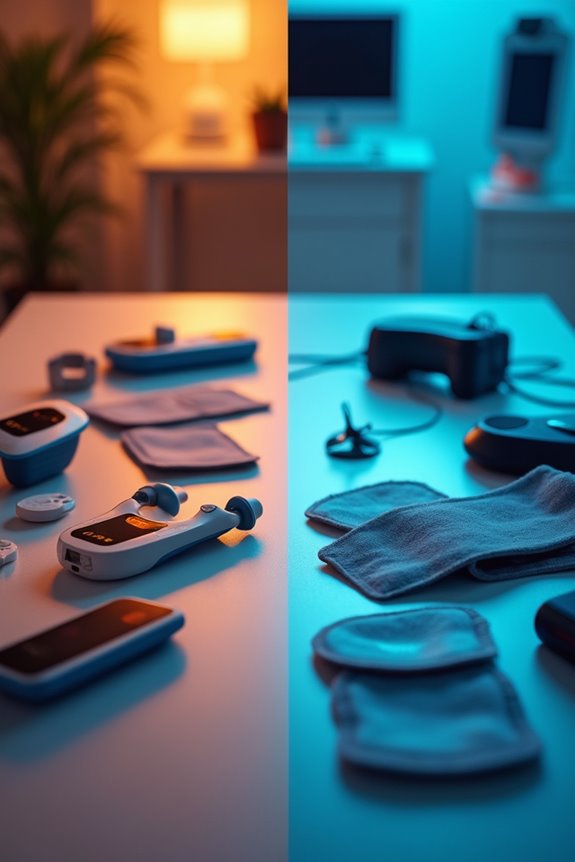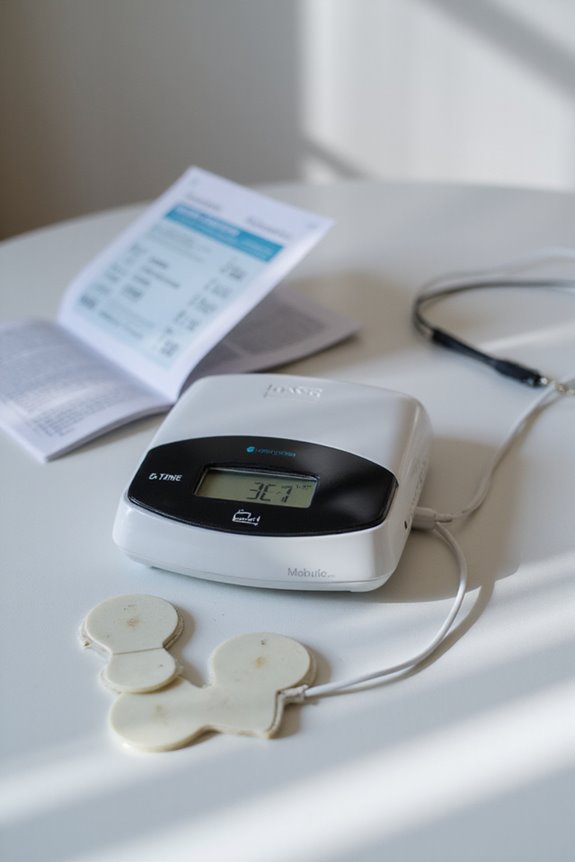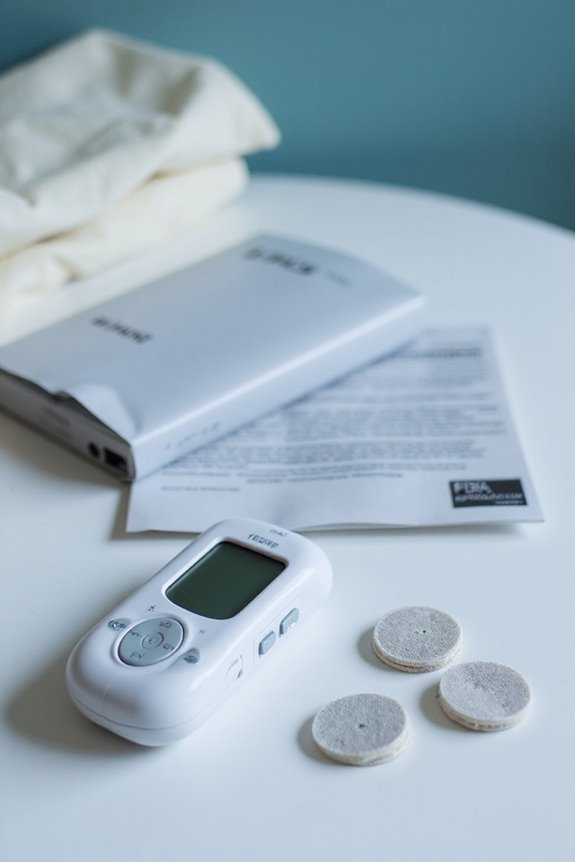Portable pain relief devices offer enhanced mobility and convenience, allowing users to engage in daily activities. However, they typically provide lower power outputs and fixed intensity settings compared to stationary devices, which excel in delivering deeper tissue stimulation and customizable treatments. While both types effectively block pain signals, portable devices are advantageous for mild to moderate pain relief. Understanding these differences will assist in choosing the most suitable device for individual needs and preferences. More information follows.
Key Takeaways
- Portable pain relief devices offer greater mobility, allowing users to engage in daily activities while receiving treatment.
- Stationary devices provide higher power and adjustable settings, suitable for deeper tissue penetration and chronic pain management.
- Portable units typically focus on mild to moderate pain relief, while stationary options target complex pain conditions effectively.
- Wireless portable devices are user-friendly and operate silently, enhancing comfort during use compared to wired stationary models.
- Both device types are effective for pain relief, but user education is crucial to prevent skin irritation and ensure safety.
Mobility and Convenience
The choice between wireless and wired portable pain relief devices greatly influences user mobility and convenience.
Wireless devices enhance user experience by eliminating cables, allowing for greater freedom of movement during therapy sessions. This portability enables users to engage in various activities, such as walking or completing light tasks, thereby promoting adherence to pain management routines.
In contrast, wired devices restrict mobility, necessitating stationary use and limiting therapy to confined locations.
Additionally, wireless models often feature device integration with rechargeable batteries, allowing for repeated use without the need for constant plugging in. Many cordless heating pads offer extended battery life that supports prolonged warmth for up to 8 hours, making them ideal for on-the-go pain relief.
Ultimately, the decision between these device types hinges on the user’s lifestyle and the importance placed on mobility versus the reliability of stationary power sources.
Power and Intensity
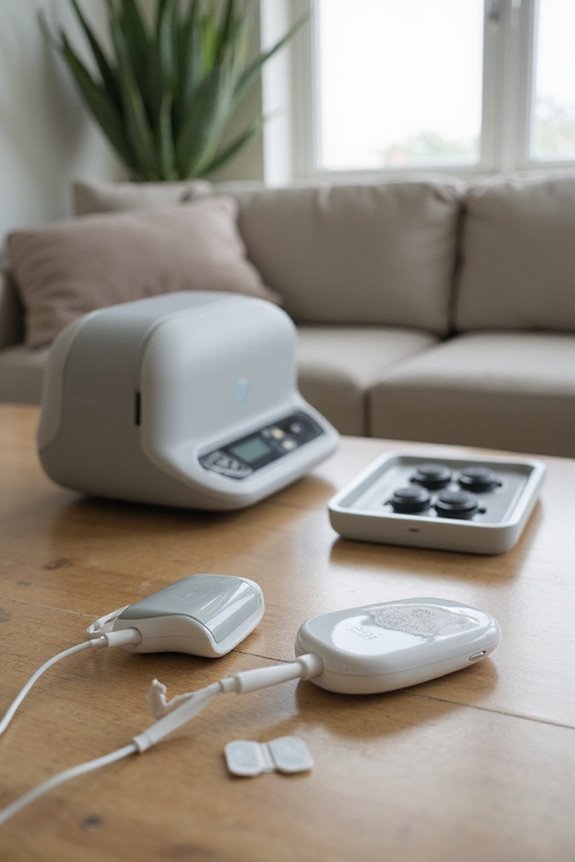
Power and intensity are critical factors that differentiate portable pain relief devices from their stationary counterparts.
- Power Output: Stationary devices typically offer higher power outputs, enabling deeper tissue penetration. In contrast, portable units provide lower intensity treatments, suitable mainly for superficial or mild pain.
- Energy Delivery: Clinical stationary devices allow for adjustable energy levels and frequencies, enhancing treatment customization. Portable devices often have fixed intensity settings, limiting their adaptability for specific pain conditions.
- Treatment Depth: Higher power in stationary units facilitates treatment of deeper musculoskeletal issues, while portable devices primarily address surface-level ailments.
Usability and Comfort
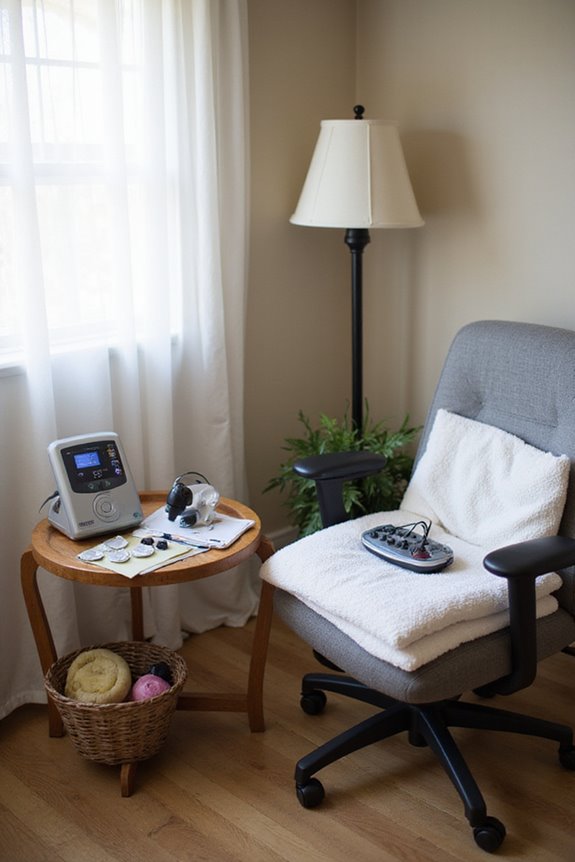
Usability and comfort are paramount when evaluating portable pain relief devices, especially considering their intended use in diverse environments.
Mobility During Use
- Portable devices are typically wireless, allowing users to maintain freedom of movement.
- Stationary devices may restrict mobility due to tethering limitations.
Ease of Application
- Portable devices often feature simpler application processes and user-friendly instructions.
- Adhesive electrode pads provide quick and comfortable application.
Comfort and Wearability
- Slim, compact designs conform to the body, enhancing wearability.
- Wireless models operate silently, contributing to user satisfaction.
User Convenience and Accessibility
- Portable devices are designed for easy transport, often including carrying cases.
- Many offer app control and customizable settings based on user feedback, improving adaptability to lifestyles. Additionally, some units, like the Wireless TENS & EMS Unit, provide enhanced usability through app control for greater convenience.
Application and Therapy Scope

Portable pain relief devices offer a range of applications and therapy options that cater to various user needs.
Mobility and Convenience
- Wireless TENS units enable freedom of movement, allowing users to engage in daily activities without interruption.
- Compact designs fit discreetly under clothing, enhancing convenience for on-the-go users.
Therapy Types
- Portable devices focus on mild to moderate pain relief in common areas, while stationary devices target complex or chronic pain through adjustable settings.
- Stationary units provide higher power and multiple channels for diverse therapeutic modalities.
Environment Adaptability
- Portables excel in various settings, including work, travel, and outdoor environments, while stationary devices are confined to fixed locations like homes or clinics.
- The flexibility of portable devices supports discreet, on-demand therapy, meeting the needs of users across different circumstances. Additionally, many units offer customizable modes for personalized pain relief, enhancing their versatility in various situations.
Effectiveness and Safety
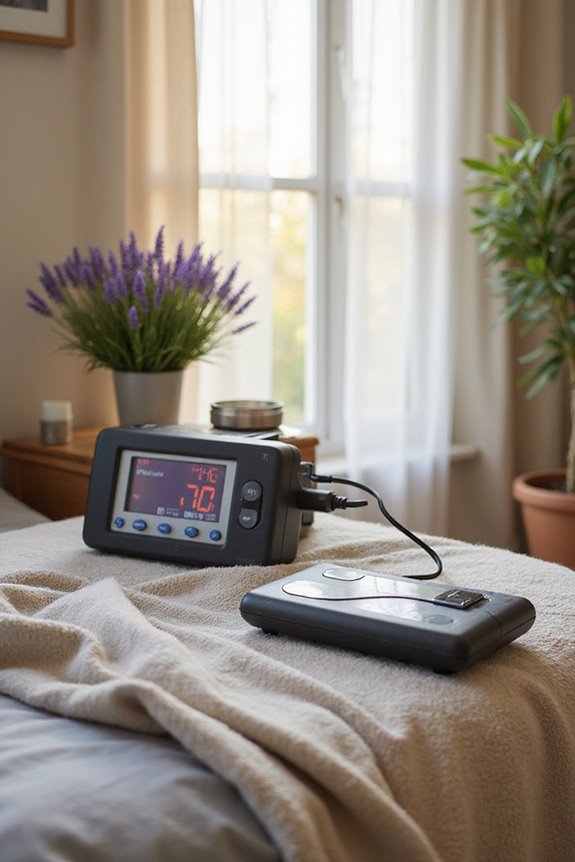
Effectiveness and safety are critical factors in evaluating pain relief devices, as they directly impact user outcomes and overall satisfaction.
Effectiveness
- Both portable and stationary devices effectively block pain signals and promote recovery.
- Stationary devices offer deeper stimulation, ideal for chronic pain, while portable devices provide targeted relief for specific areas.
- Studies show portable TENS devices can yield significant pain reduction lasting up to 48 hours.
- Many users report effective pain relief for conditions such as chronic pain and muscle soreness with portable devices.
Safety
- Both device types are generally safe when guidelines are followed.
- Portable devices reduce risks associated with wires, while wired devices provide stable stimulation.
- User education is essential to prevent skin irritation and burns.
Cost and Accessibility
Cost and accessibility are significant considerations for individuals evaluating pain relief devices.
Price Range
- Portable TENS units range from $40 to $350, accommodating various budgets.
- Stationary PEMF devices typically start at $500, with premium models exceeding thousands.
Accessibility Factors
- Portable devices are lightweight and often wireless, promoting on-the-go use.
- Stationary devices are bulky, requiring dedicated space and limiting mobility.
Availability
- Portable units are widely available online and in retail, appealing to diverse consumer demographics.
- Stationary devices often require consultations or prescriptions for purchase.
Maintenance Costs
- Portable devices generally incur lower ongoing costs, mainly for electrode pads and batteries.
- Stationary devices may necessitate specialized maintenance, amplifying long-term expenses.
- Additionally, users appreciate the adhesive quality of portable TENS unit pads for effective pain relief.
User Considerations and Preferences
When evaluating pain relief options, how do user preferences shape the choice between portable and stationary devices?
Mobility and Convenience
- Portable devices, like wireless TENS units, offer high mobility, allowing users to engage in daily activities.
- Stationary devices, requiring fixed positions, limit movement and flexibility.
Customization and Therapy Intensity
- Stationary units often provide more powerful therapy options, while portable devices may have fewer intensity settings.
- Both allow for customization based on individual needs.
User Comfort and Discretion
- Portable devices feature discreet designs, enhancing user comfort and confidence in public settings.
- Stationary units may be bulkier and less comfortable for prolonged use.
User preferences heavily influence device selection, as individuals seek options that cater to their specific needs and lifestyles. Additionally, heating pads with customizable heat settings offer versatile options for tailored therapy at home.
Frequently Asked Questions
Can I Use Portable Devices While Exercising?
Using portable devices during exercise is possible, provided they maintain compatibility with varying exercise intensity. Users should verify adhesive pads remain secure and the device supports movement, enhancing comfort and effectiveness during physical activity.
How Long Do Portable Device Batteries Typically Last?
Battery life in portable pain relief devices varies, with some offering 5 to 250 hours depending on intensity and usage. Charging options include rechargeable lithium-ion batteries, enhancing convenience and reducing the need for frequent replacements.
Are Portable Devices Suitable for Children?
Portable pain relief devices can be suitable for children, but safety concerns linger, prompting age recommendations. With proper guidance, these devices offer a noninvasive approach, allowing parents to manage pain effectively and enhance comfort during procedures.
Can I Use Multiple Portable Devices at Once?
Using multiple portable devices simultaneously is feasible but requires safety precautions and careful management of device compatibility. Users should consult healthcare professionals to guarantee effective treatment without overstimulation or adverse effects on the body.
What Is the Average Lifespan of Electrode Pads?
Like a beloved pair of shoes, electrode pad durability typically lasts 20 to 30 uses. Regular maintenance tips, such as cleaning skin and proper storage, enhance longevity, ensuring users continue to feel their best.

